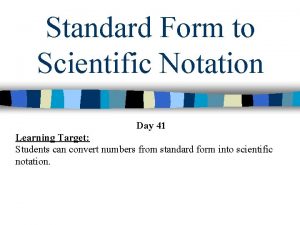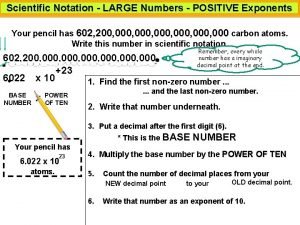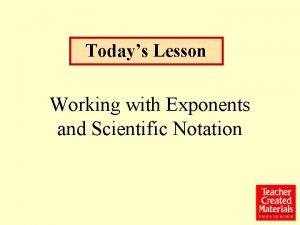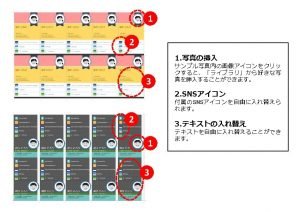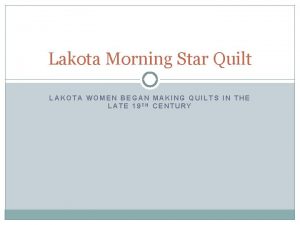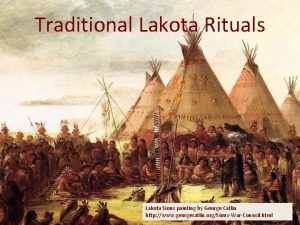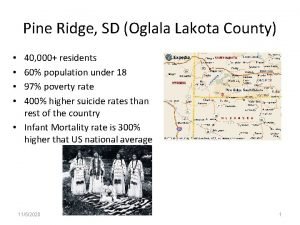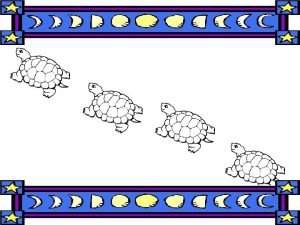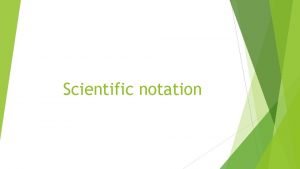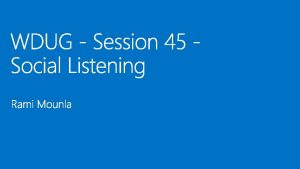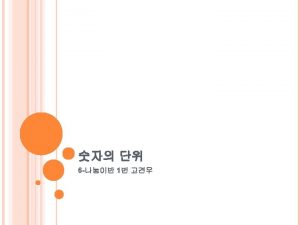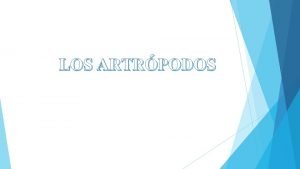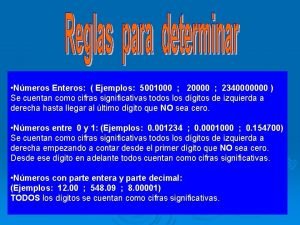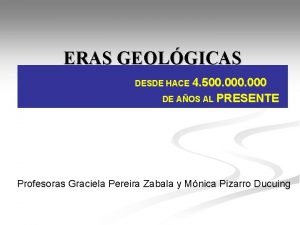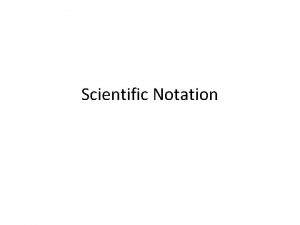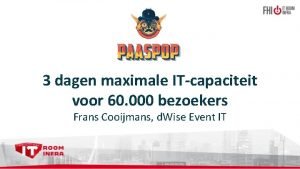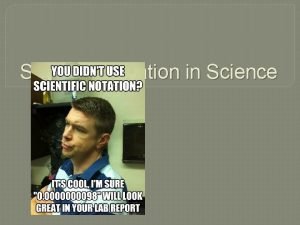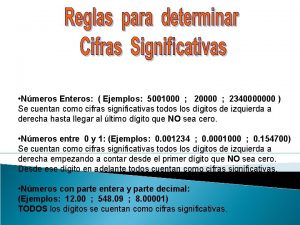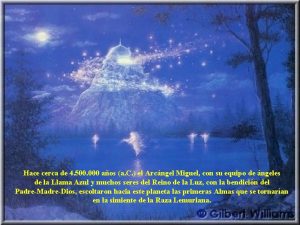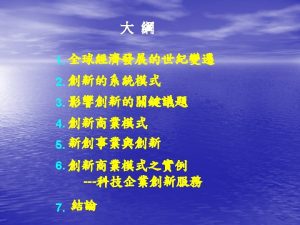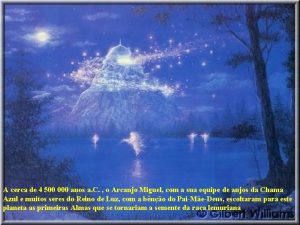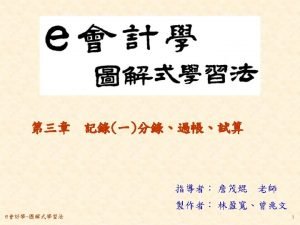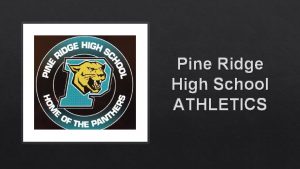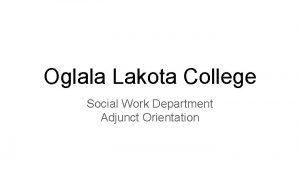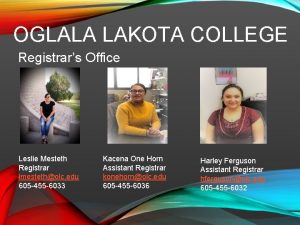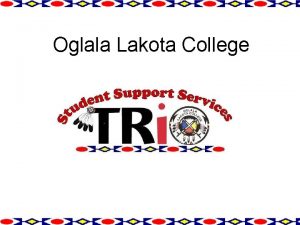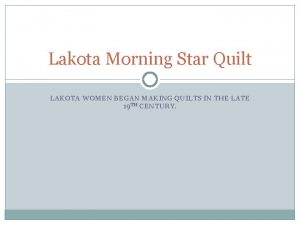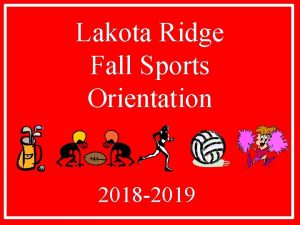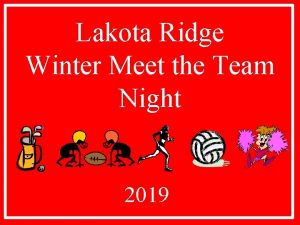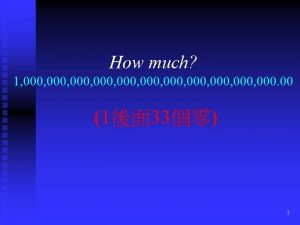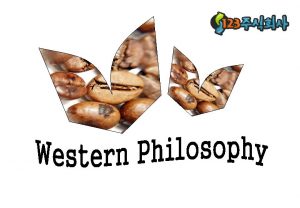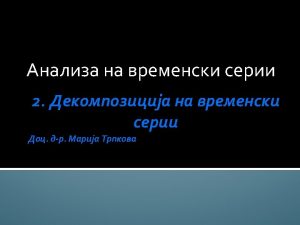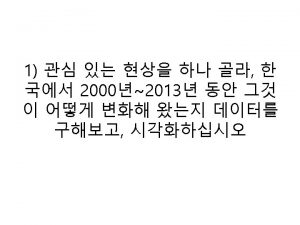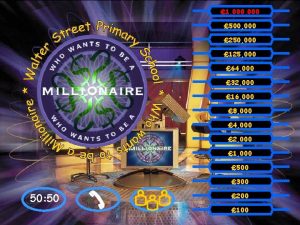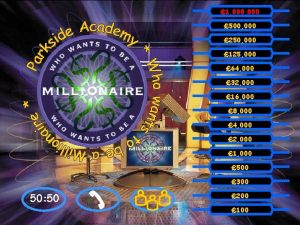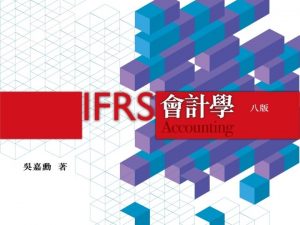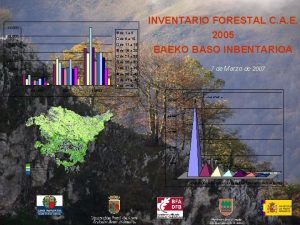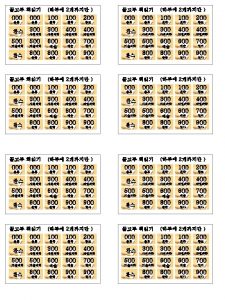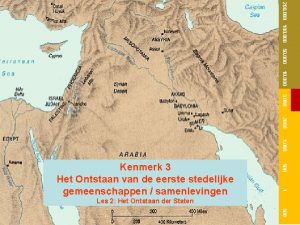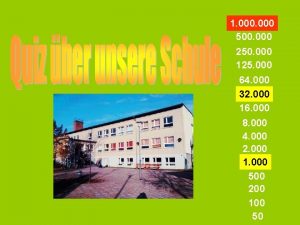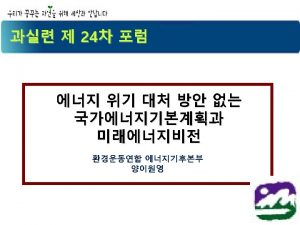Pine Ridge SD Oglala Lakota County 40 000





























- Slides: 29

Pine Ridge, SD (Oglala Lakota County) 40, 000+ residents 60% population under 18 97% poverty rate 400% higher suicide rates than rest of the country • Infant Mortality rate is 300% higher that US national average • • 11/5/2020 1

• Extreme Shock and Trauma to the individual, family and Nation • Shockwaves still felt today, e. g. posttraumatic stress syndrome • Entire generation of knowledge and Impact of teachings not passed on WOUNDED KNEE • Disconnection of Spirit MASSACRE in (from individual, family, 1890 nation) 11/5/2020 2

• Lakota belief that mental, emotional, physical and spiritual aspects of a person are integrated • What affects one aspect of person affects all other aspects of that person (e. g. Historical Grief: Impact of 1890 Wounded Knee Massacre REINTEGRATION OF MIND, SPIRIT, BODY, EMOTIONS • Spirit must be reintegrated with mind, body and emotions in order for healing to begin • Specific ceremonies and cultural interventions among Indigenous peoples to begin the reintegration and healing process 3

11/5/2020 4

Tiospaye Sakowin Woonspe na Woapiye Otipi (Seven Sacred Families Education and Healing Center) Mission Statement: Lakol wicohan na woope ogna unyanpi hehan, oyate ki tanyan wiconi. Canke he un, lakol ounye ki unglu kini pi When the people followed the Lakota life ways and laws, the people flourished. Therefore, the Seven Families Education and Healing Center promotes the rebirth of the Lakota life ways and laws through education, healing and collaboration Philosophy: The philosophy of the Seven Families Education and Healing Center, involves reclaiming Oglala Lakota self determination through using, modeling and teaching Oglala Lakota culture, language, tradition and spirituality.

v Collaborative program of the Medicine Horse Society and Knife Chief Buffalo Nation Society, both of which operate under fiscal agent Village Earth Inc. v Provide a foundation of 20+ years working with Lakota elders and traditional healers to revitalize and strengthen the Lakota life ways and laws through education, healing and collaboration. v Primary programmatic focus is to empower the Lakota Tiwahe (families) in reclaiming Lakota identity. (achieved through integrating the Lakota Customary, Natural, and Spiritual laws within the educational process, and to revitalize and implement the Lakota language through education and practice. )

v Organization works with community leaders, families and Lakota Oyate to provide healing opportunities to over 100 youth per year. v Work with youth to address unresolved trauma and emotional issues during camps Ø Teca Woasniye Wicoti (Youth Healing Camp) All ages/both genders Ø Wakanyeja Wicoti (Children’s Camp) Pregnant women to 11 yrs Ø Wikoskalaka Yuwita Pi (Lakota Gathering of Young Women) 12 -18 yrs Ø Lakota Koskalaka Wica Yuwita Pi (Lakota Young Men's Gathering)

PLANNING, DESIGNING, ASSESSING A SYSTEM OF CARE FOR CHILDREN WITH “SERIOUS EMOTIONAL DISTURBANCES” Defining “Serious Emotional Disturbance” for Lakota Cultural Appropriateness (Tawacin Sagya Wokakije – strong suffering of the mind and heart) 8

Teca Woasniye Wicoti (Youth Healing Camp) April 2015 - In response to the 20+ suicides from December 2014 to April 2015 (ages 11 -24) - According to Aberdeen area IHS, 400+ suicidal ideations and attempts - Understood this as a tragic message from our youth that life is not worth living - As adult relatives, we sought to instill in youth, the Lakota belief that every individual has a purpose on earth and that resiliency to confront life’s challenges can be achieved. - Through this camp, learning, recreational and healing activities will be offered as a way to give life to the values, gifts and teachings provided by Tunkasila (Grandfather/Creator) for their healing. - Through instructions from ancestor spirits and the elders, the planning of the camp began - Focus was 11 -18 yrs, referrals from school counselors, Tribal CPS, Court Advocates, Emergency Youth Shelter, JDC. - 4 Teams (mental health assessment/healing plan, language and ceremonial advocacy, male/female activities and elder’s group.

Elder’s Group -Focus on the spiritual and ceremonial aspects of the camp, serves as the overseers of the camp and provides guidance to all teams Male/Female Groups -Developing gender appropriate activity schedule and agenda Language Advocacy - Identified 3 male and 3 female fluent Lakota speakers to work with assessment team - Responsible for advocating on behalf of child and family and reporting recommendations from the ancestor spirits and Wakan Iyeska (Interpreter of the Sacred) to the family and assessment team. Fundraising- Go. Fund. Me Campaign over the course of a month

Mental Health Assessment and Healing Plan Team Tasked with: 1) Identify assessment tools that’s most align with Lakota Spiritual assessment (ACE and SIQ) 2) Identify the licensed professional to oversee MHAHP Team 3) Identify “waokiyapi”. One mentor and language advocate per four children (three males, three females) 4) Plan Lakota Mental Health First Aid Training (similar to MHFA) for all mentors and camp staff (GOAL: To provide information on a Lakota cultural perspective on responding to trauma using a first aid approach. ) Also certified in CPR and First Aid 5) Develop protocol and procedures for implementation of assessment 6) Develop list of necessary forms and community resource booklet

Procedures for Assessment Team -Initial Registration is completed 2 weeks before camp -Participants and parents/guardians complete application process which ensuring all necessary forms are completed and/or ready to fill out 1. Consent form 2. Release form 3. ACE/SIQ Questionnaire 4. Lakota Cultural Service Form 5. Administration of Medication 6. Wakan Iyeska (Interpreter of the Sacred) Diagnosis Summary 7. Healing Plan 8. Aftercare Plan 9. HIPAA Release Form 10. Liability Waiver 11. Community Resource List

Assign and introduce child to team member Review and Sign Forms Assessment Process Flowchart Administer ACE and SIQ Questionnaire, Fill out Cultural Services Request and Healing Plan Staff w/ Languag e Advocate Staff w/ Wakan Iyeska 11/5/2020 Develop Aftercare Plan w/ Child and Provide Resource List Spiritual Assessment (ceremony) & fills out Diagnosis and Recommendations (after) 13

Advocates will thoroughly inform Wakan Iyeska of appropriate spiritual intervention the participant is requesting. Advocates will work with camp mentors to provide thorough orientations of each spiritual intervention that is planned to take place for each participant. • • Inipi- Purification Lodge This ceremony cleanses the body, spirit and mind. Lowanpi- Doctoring ceremony conducted to address deeper emotional, physical and psychological issues • Lakol Caje Icu Pi- Lakota Name to anchor him/her to the earth- believed that the Lakota spiritual entities recognize us by our spirit names and that when we pass from this world, our ancestors will call us and guides us to their world using our spirit name. • Isanti Awica Lowanpi- They Sing for her that Lives Alone Young women’s transition into Womanhood • Wanasa- Buffalo Kill, Manhood Ceremony 1 of the 4 rights of becoming a young man • Wapunkeska- Grounding Ceremony for Females that lays down a path for their future • Wopakinte- Spiritual Cleansing ceremony signifies wiping away the spiritual residue left by the intergenerational trauma that is transferred from our ancestors to the youth and well as the youth’s own historical trauma. Without a “Wopakinte”, our youth can become burdened and become vulnerable. These cultural interventions along with other interventions can prevent

Wopasi (Assessment) GAF Score Description Scale of 1 to 7 Hutkan: Root of the problem Described using Spiritual Assessment Woksape Cognitive Tacan Physical Tawacin Emotional Nagi Spiritual Care planning recommendations: Woksape (Cognitive) Tacan (Physical) Tawacin (Emotional) Nagi (Spiritual) Okapha Transgenerational nature: ·Presence ·Description Level: severity 1. Ikame/stressed 2. Ikakije/suffer 3. Iyanuge/ Twisted in the personality

Camp Activities/Teachings Oinajin Topa- Stages of Life, teaches their spiritual place in life Wotakuye- Protocol/Lakota Kinship, Ceremonial Protocol establishing kinship ties Wokpan- Spiritual Took Kit, Use of Sage, sweetgrass, cedar and shell

Ti Ikciya- Setting up Tipi, teaches knowledge and significance of the tipi Oka Unspe Wicakiyapi. Drumming and Singing, learning ceremonial songs from mentors Wicahpi Wicoiye- Star Knowledge, ceremonial connection and guidance Itazipa Kaga- Bow Making, teaches the significance of bringing back the bow Sunka Wakan Oyate To Woonspe- Traditional Equine Therapy, Healing Ucangleska-Talking Circle, end of day reflection on feeling and experience

Healing & Assessment Plan Example: 14 yr old girl Mother physically abused while in womb Age 0 Nagi (spirit) Strengths 1. Volleyball Player 2. Goes for Walks 3. Healthy, No physical illness 4. Good eyesight Challenges 1. Uses marijuana 2. Drinks alcohol 3. Not enough exercise 4. Doesn’t eat healthy Strengths 1. Has Lakota Name 2. Knows some Culture 3. Knows what Aziliya is 4. Been to Sundance Challenges 1. Never Prays 2. No family support 3. No Ride to Inipi 4. Uses marijuana- sees bad spirits Resources 1. Lakota language and culture teacher at school 2. Grandmother 3. Mom’s friend Age 50 Tacan (Physical) 4. Strengths 1. Cries when sad 2. Talks to friend about feelings 3. Doesn’t like to fight 4. Poetry Helps with Sadness Challenges 1. Often Sad Strengths 2. Mom is verbally abusive 1. Like School 3. Dad is in prison 2. Writes Poetry 4. Sexually abused by Stepdad 3. Likes Computers 4. Likes to Draw Challenges 1. Poor attendance, oversleeps 2. Poor grades 3. No books at home, no library 4. Adults party, lack of sleep Went into foster care 8 yrs old Sexually abused by stepdad 11 yrs Age 12 Woksap e (Mind) Started drinking and huffing 12 yrs Attempted suicide 13 yrs old Age 21 Tawacin (Emotional ) 11/5/2020 18

Aftercare Plan Example: 14 yr old girl Age 0 Nagi (spirit) Challenges Strengths 1. I’m beautiful 2. Loves riding horses 3. Healthy, No physical illness 4. Good eyesight Strengths 1. Has Lakota Name 1. Finding better Friends 2. Completed Inipi 2. Quit marijuans 3. Finding Ride to Fitness 3. Knows how to pray 4. Received doctoring Center 4. Choose healthier foods (traditional foods) Resources 1. Hunka Parent 2. Grandmother 3. Lakota language teacher at school 4. Peer mentor/ camp assessment team Resources Age 50 Tacan (Physical) 1. Volleyball Coach 2. Fitness center trainer 3. Peer mentors 4. IHS Nutrionist Strengths 1. Cries when sad 2. Talks to friend about feelings 3. Doesn’t like to fight 4. Poetry Helps with Sadness Challenges 1. Staying safe 2. Maintain Self Esteem 3. Fear of men, triggers 4. Continue healing from sexual abuse Strengths Challenges 1. Learned how to bead 2. Writes Poetry 3. Learned Star Knowledge 4. Planning for college 1. Improve attendance 2. Improve grades 3. Finding quiet place to study 4. Needs support and encouragement Resources 1. Camp mentor 2. Grandmother 3. Horse Spirit Society 4. IHS Counselor 1. School counselor 2. Lakota language teacher 3. Friends at Camp 4. Peer mentor/ camp assessment team Age 21 Tawacin (Emotional ) 11/5/2020 Challenges 1. Continue to attend inipi 2. Family Support 3. Quit marijuana 4. Need a safe home Receive d Lakota name 10 yrs old Age 12 Woksap e (Mind) Received Wopakinte (spiritual cleaning) Woapiye (Doctoring) to address sexual abuse Received healing from riding horse 4/3/15 and 4/3/15 19

Oglala GAF Wakan Iyeska Assessment: Example Age 0 Nagi (spirit) 7 6 Severity is 6 due to abuse in the womb, sexual abuse and suicide attempt 5 4 Age 50 Tacan (Physical) Severity is 4 due to drug/alcohol abuse, no healthy eating Severity is 6 due sexual abuse, incarcerated parent, emotional abuse, alcohol abuse 11/5/2020 3 2 1 Recommendation s: Attend Inipi as often as can, participate in Womanhood ceremony and grounding ceremony, 2 nd doctoring with family in attendance, and cleansing the spirit at least 4 times throughout the year Age 12 Woksap e (Mind) Severity is 2 due to lack of sleep, no focus in school Age 21 Tawacin (Emotional ) 20

Sharing the Aftercare Plan With permission from youth and family, Aftercare Plan is shared with all child and family serving agencies/school personnel/ other family members/IHS personnel/ Mentor/equine therapy - CPS advocate School counselor IHS nutritionist Behavioral Health Specialist Fitness center trainer Volleyball Coach Lakota language and culture teacher Mentor is the liaison between all parties and youth/family. Convene meeting quarterly to address updates/goals/challenges and adjust aftercare plan as necessary. Sometimes by the 2 nd or 3 rd meeting, parties are no longer needed at the table because the youth no longer needs that help.

Aftercare Plan 1 yr later Example: 15 yr old girl Strengths Age 50 Tacan (Physical) 1. Quit alcohol/drugs 2. Participates in Crazy Horse Ride 3. Learned how to make wasna and cherry juice for ceremony 4. Walks at track 5 days a week and participates in running group at Fitness Center Strengths 1. Uses Wokpan when feeling down 2. Able to talk to mother about her feelings 3. Attending sessions with IHS counselor 4. Understands intergenerational trauma of her mother/grandparents Age 0 Nagi (spirit) Strengths 1. Participated in Challenges 1. Maintaining old friends due to different habits Challenges Womahood Ceremony 2. Returned as mentor to camp 3. Prays Daily 4. Continues to attend inipi 5. Mother has begun to attend inipi Strengths 1. Too much time in 1. Beads as a way to between IHS sessions get extra money 2. Joined spoken word class 3. Joined Lakota language club 4. Looking at colleges 5. Grades improved 6. Quit drinking and smoking marijuana Age 21 Tawacin (Emotional Challenges 1. Ride to Inipi Challenges Age 12 Woksap e (Mind) 1. Access to library Participated in 4 day womanhood and grounding ceremony, regularly attends inipi with mentor, received another doctoring to address sexual abuse, mother received doctoring, helps in preparation of Sundance ceremony ) 11/5/2020 22

201524 Youth attended Healing Camp (12 males/12 females) 19 successfully completed healing plan 1 yr later (12 females/7 males) 10 females participated in Womanhood Ceremony 3 months later 9 males participated in Manhood Ceremony 1 month later 5 males that did not successfully complete healing plan had revised healing plan 2015/2016 - 68 participants in Womanhood Camps 62 in Manhood Camps 48 Children’s Camp 2017 Camps to be held in Black Hills, SD 11/5/2020 23

Child Substance Abuse Welfa l pecia S / n o i t Educa ion Educat re Tiwah e Juvenile Court and JDC Law Enforcement Wakanyeja Parent Advocacy Group and b o ent/J ent m y lo m Emp Develop Skills Eme y rgenc lter e h S Youth Housing Hea l Em th and erge ncy Se WOKIGLEGA – THE GOAL Okiciyapi – Helping Each Other COMMUNITY TEAM rvic es 24

Recommendations for Working with Native Youth with Co-Occurring Disorders • Develop, implement and evaluate culturally-based diagnostic and care models; particularly for reintegration of spirit with mind and body. • Leadership – key to change • Collaboration • Using the strengths of the culture and natural supports, e. g. the extended family, culturallybased diagnostic systems and interventions • Partnering with Families of Youth 11/5/2020 25

Barriers to Family Partnerships • Not including them in planning from the very beginning • Negative Staff attitudes – e. g. looking down on families, labeling them as “dysfunctional”; blaming parents for mental health of child • Policies and rules that restrict parent participation and contact • Acting as if the child’s problem/need exists in isolation. • Resistance to sharing power with parents/families in therapeutic relationship • Logistics; availability of transportation; geographic distances • Work schedules of staff (children and families need help in the evenings, weekends and holidays not just Monday through Friday, 8: 30 to 5: 00 p. m. • Work schedules of parents/caregivers • School/activity schedules of children 26

Increasing Success of Partnerships with Families • Building on the strengths of the child and family instead of focusing on the deficits (NO LABELS) • Including parents/caregivers in training sessions and program meetings • Including parents/family members in the decision making • Offering childcare, transportation, gas money and reimbursement for expenses and time taken off from work • Training staff to be respectful of parents/caregivers and children; e. g. welcoming them, talking “with” them instead of “at” them and “to” them. • Lakota example: treating children, parents/family members as relatives rather than as “clients”, “cases” 11/5/2020 27

Collaboration is Key – We cannot do it alone “So I know it is a good thing I am going to do; and because no good thing can be done by any man alone, I will first make an offering and send a voice to the Spirit of the World, that it will help me to be true”. Black Elk, 1930 28

OUR HOPE FOR THE FUTURE 11/5/2020 29
 97 700 000 000 000 000 000 000 in scientific notation
97 700 000 000 000 000 000 000 in scientific notation Express 602200 in scientific notation.
Express 602200 in scientific notation. 7 500 000 000 000 000 000 in scientific notation
7 500 000 000 000 000 000 in scientific notation 090-0000-0000
090-0000-0000 What are the two focal points of a pattern area?
What are the two focal points of a pattern area? Lakota star quilt
Lakota star quilt Medicine wheel colors
Medicine wheel colors Sweat lodges
Sweat lodges Sans arc lakota
Sans arc lakota Gaf score
Gaf score Where did the kwakiutl live
Where did the kwakiutl live Medicine wheel lakota
Medicine wheel lakota Moon in lakota
Moon in lakota Powhatan lakota pueblo
Powhatan lakota pueblo Express 4,980,000, 000 in scientific notation
Express 4,980,000, 000 in scientific notation 1 600 000
1 600 000 1000*10000
1000*10000 Quelicerata
Quelicerata Mega micro nano
Mega micro nano 2,340,000,000
2,340,000,000 4 500 000 000
4 500 000 000 1,000 x 3,000
1,000 x 3,000 Advantages of scientific notation
Advantages of scientific notation 60 000 000
60 000 000 450 000 000 in scientific notation
450 000 000 in scientific notation Números enteros
Números enteros 4 500 000 000
4 500 000 000 260 000 000
260 000 000 4 500 000 000
4 500 000 000 4 000 000
4 000 000
